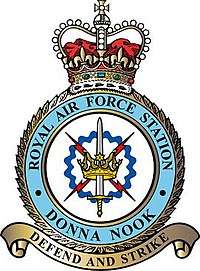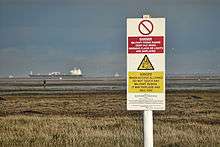RAF Donna Nook
Royal Air Force Donna Nook or more simply RAF Donna Nook is a bombing range[1] in East Lindsey in north-east Lincolnshire in England. It is maintained by the Royal Air Force and used by NATO aircraft.
| RAF Donna Nook | |
|---|---|
| North Somercotes, Lincolnshire in England | |
 Station Crest | |
 RAF Donna Nook Shown within Lincolnshire | |
| Coordinates | 53°28′29″N 000°09′07″E |
| Type | Bombing range |
| Site information | |
| Owner | Ministry of Defence |
| Operator | Royal Air Force |
| Site history | |
| Built | (Airfield) 1936 |
| In use | 1940-Present |
History

The area has been in continual use since the First World War and was established as a protection point from Zeppelins trying to enter the Humber area.[2] Donna Nook is just north of North Somercotes and is also a 6.2 miles (10 km) nature reserve with a large seal habitat in the early winter maintained by the Lincolnshire Wildlife Trust.[3] It is the only national nature reserve in the UK on MOD land, and was opened on 18 July 2002 by Air Commodore Nigel Williams. The bombing range covers an area of 885 hectares on land and 3200 hectares at sea.[4]
Airfield
There was once a minor airfield there which was operational from 1936 and used as a decoy up until 1945. The airfield was home to No. 206 Squadron RAF[5] from August 1941 - July 1942. The airfield acted as a Relief Landing Ground (RLG) for RAF North Coates,[6] a former airfield (still in physical existence) which is three miles to the north-west along the coast.
Radar station
However, during the Second World War, RAF Donna Nook referred to a Chain Home Extremely Low (CHEL) radar station, sited a short distance away from the current establishment. This utilized a 10-cm radar set to track both low-flying intruders and German E-boats cruising offshore, and was operational in this role from 1943-1945. From evidence in his authorized biography (Odyssey: The Authorized Biography of Arthur C. Clarke; Neil McAleer, Gollancz, 1992) it appears that it was to RAF Donna Nook that the young Sir Arthur C. Clarke was posted in 1943, shortly after an interview with Wing Commander (later Sir) Edward Jefferson,RAF, who was subsequently Director of Telecommunications for the General Post Office.
Bombing range
The bombing range first opened up in 1926[7] with three bombing targets including one which was illuminated for night time bombing practice. The range closed in 1946 but was re-opened in 1976 when RAF Theddlethorpe was closed due to complaints from those living nearby.[8] RAF Donna Nook is still used as an Air Weapons Range by UK, USAFE & NATO users and since 2008 has been administered by Defence Infrastructure Organisation (DIO), formerly Defence Training Estates (DTE).
See also
References
Citations
- "Donna Nook". RAF.mod. Royal Air Force. Retrieved 17 May 2016.
- Owen, Moira (2012). "Donna Nook gets the seal of approval". Sanctuary. Ministry of Defence (41): 20–21. ISSN 0959-4132.
- "Donna Nook national nature reserve". Lincolnshire Wildlife Trust. Retrieved 17 May 2016.
- "Public Information Leaflet" (PDF). Defence Training Estates East. Ministry of Defence. Retrieved 17 May 2016.
- "Donna Nook". Airfields of Britain Conservation Trust. Retrieved 7 June 2020.
- Historic England. "RAF Donna Nook (1393840)". PastScape. Retrieved 17 May 2016.
- "Bombing range on Humberside, Donna Nook depot". Yorkshire Post & Leeds Intelligencer. 29 September 1926. p. 9. Retrieved 16 June 2016.(subscription required)
- Halpenny 1981, p. 87.
Bibliography
- Halpenny, Bruce Barrymore. Action stations 2: Military airfields of Lincolnshire and the East Midlands Cambridge, UK: Patrick Stephens Publishing, 1981. ISBN 0-85059-484-7.
External links
Video clips
- Weapons burst by an A-10 Thunderbolt II
- Flyby on range by a BAE Hawk, Panavia Tornado and Eurofighter Typhoon
- Gunfire on the range by a SEPECAT Jaguar
- Bomb practice by an A-10 Thunderbolt II
